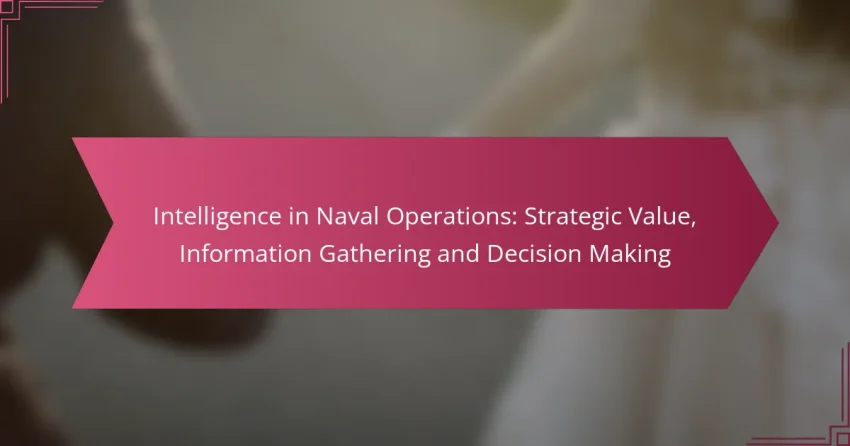Intelligence plays a crucial role in naval operations by providing essential information that shapes strategy and enhances situational awareness. Through various intelligence-gathering methods, such as signals, human, and geospatial intelligence, naval forces can effectively anticipate threats and make informed decisions in ever-changing maritime environments.
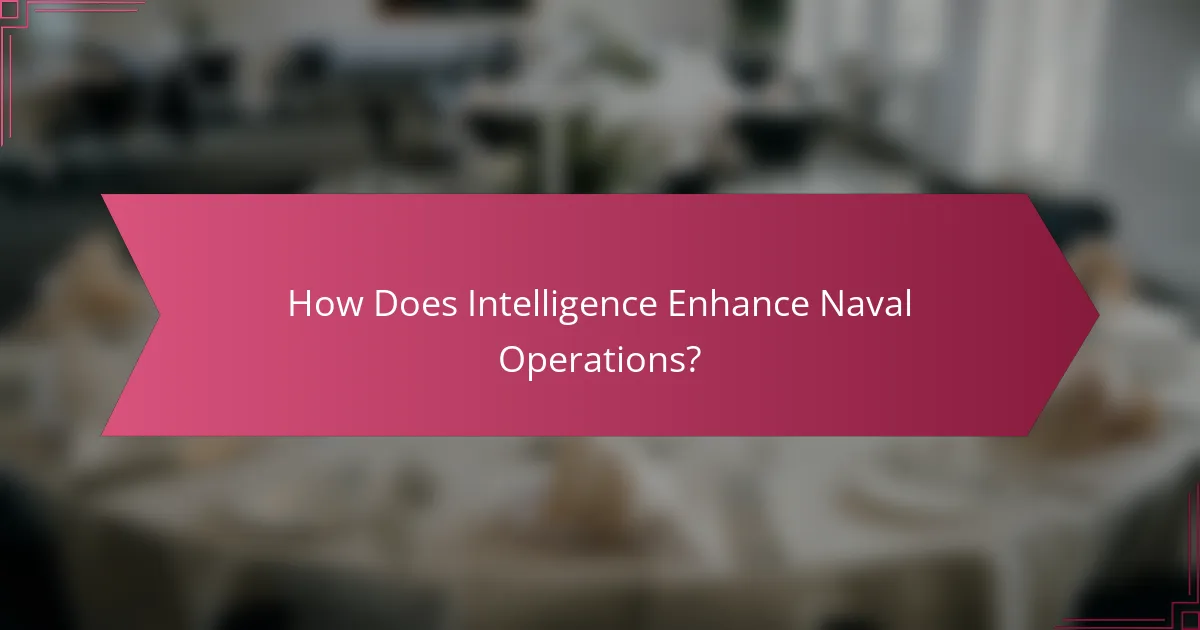
How Does Intelligence Enhance Naval Operations?
Intelligence significantly enhances naval operations by providing critical information that informs strategy, improves situational awareness, and supports effective decision-making. By leveraging various intelligence-gathering methods, naval forces can better anticipate threats and optimize their responses in dynamic maritime environments.
Improved situational awareness
Enhanced situational awareness is crucial for naval operations, as it allows commanders to understand the operational environment comprehensively. This includes monitoring enemy movements, weather conditions, and maritime traffic. Utilizing satellite imagery, reconnaissance aircraft, and real-time data feeds helps create a clearer picture of the battlefield.
Naval forces can employ technologies like Automatic Identification Systems (AIS) to track vessels and assess potential threats. This proactive approach enables timely responses to emerging situations, reducing the risk of surprise attacks and improving overall mission readiness.
Informed decision-making
Intelligence facilitates informed decision-making by providing commanders with the necessary data to evaluate options and potential outcomes. Access to accurate and timely information allows for strategic planning and operational adjustments based on current conditions. This adaptability is vital in fast-paced naval engagements.
For instance, intelligence reports may reveal enemy capabilities or vulnerabilities, guiding decisions on whether to engage or withdraw. Commanders can weigh the risks and benefits of various tactics, ensuring that actions align with broader mission objectives.
Enhanced mission success rates
By integrating intelligence into naval operations, forces can significantly enhance mission success rates. Accurate intelligence reduces uncertainty, enabling more effective planning and execution of operations. This leads to a higher likelihood of achieving strategic goals while minimizing casualties and resource expenditure.
Historical examples demonstrate that operations backed by robust intelligence often yield better outcomes. For instance, during the Gulf War, the use of intelligence-driven strategies allowed coalition forces to achieve rapid victories with fewer losses. Investing in intelligence capabilities is therefore essential for modern naval forces aiming to maintain a tactical edge.

What Are the Key Information Gathering Techniques?
The key information gathering techniques in naval operations include signals intelligence (SIGINT), human intelligence (HUMINT), and geospatial intelligence (GEOINT). Each method plays a critical role in enhancing situational awareness and supporting decision-making processes in maritime environments.
Signals intelligence (SIGINT)
Signals intelligence (SIGINT) involves intercepting and analyzing electronic communications and signals. This technique can provide insights into enemy movements, intentions, and capabilities by monitoring radio, satellite, and other forms of communication.
Naval forces often utilize SIGINT to gather real-time data, which can be crucial for tactical operations. For instance, detecting a fleet’s communication patterns can reveal their operational plans or alert naval commanders to potential threats.
Human intelligence (HUMINT)
Human intelligence (HUMINT) is derived from interpersonal interactions and the collection of information from human sources. This technique may involve recruiting informants or conducting interviews to obtain insights that are not available through technical means.
In naval operations, HUMINT can be particularly valuable for understanding local conditions, cultural nuances, and the intentions of adversaries. However, it requires careful management to ensure the reliability of sources and to mitigate risks associated with espionage.
Geospatial intelligence (GEOINT)
Geospatial intelligence (GEOINT) focuses on the analysis of imagery and geospatial information to assess physical features and activities. This includes satellite imagery, aerial photographs, and mapping data, which can help in visualizing operational environments.
Naval operations benefit from GEOINT by using it to identify strategic locations, assess terrain, and monitor changes over time. For example, analyzing coastal topography can aid in planning amphibious assaults or naval maneuvers. Effective use of GEOINT requires integration with other intelligence types to enhance overall situational awareness.

How Is Data Analyzed for Strategic Decisions?
Data analysis for strategic decisions in naval operations involves integrating various data sources to inform command decisions. This process enhances situational awareness and supports timely, informed actions in complex maritime environments.
Data fusion techniques
Data fusion techniques combine information from multiple sources to create a comprehensive picture of the operational environment. This can include integrating satellite imagery, radar data, and intelligence reports to improve decision-making accuracy.
Common methods include sensor fusion, where data from different sensors is merged, and multi-source fusion, which integrates information from various intelligence disciplines. Effective data fusion can significantly reduce uncertainty and enhance the reliability of strategic assessments.
Predictive analytics
Predictive analytics uses historical data and statistical algorithms to forecast future events or trends in naval operations. By analyzing past engagements and operational patterns, commanders can anticipate potential threats and opportunities.
For example, predictive models can assess the likelihood of enemy movements based on previous behaviors, allowing for proactive measures. Utilizing these analytics can lead to more effective resource allocation and mission planning.
Real-time data processing
Real-time data processing enables immediate analysis of incoming information, which is crucial in dynamic naval environments. This capability allows for quick adjustments to strategies based on the latest intelligence and situational changes.
Technologies such as edge computing and advanced algorithms facilitate the rapid processing of data from sensors and communication systems. Implementing real-time data processing can significantly enhance operational responsiveness and effectiveness in decision-making.
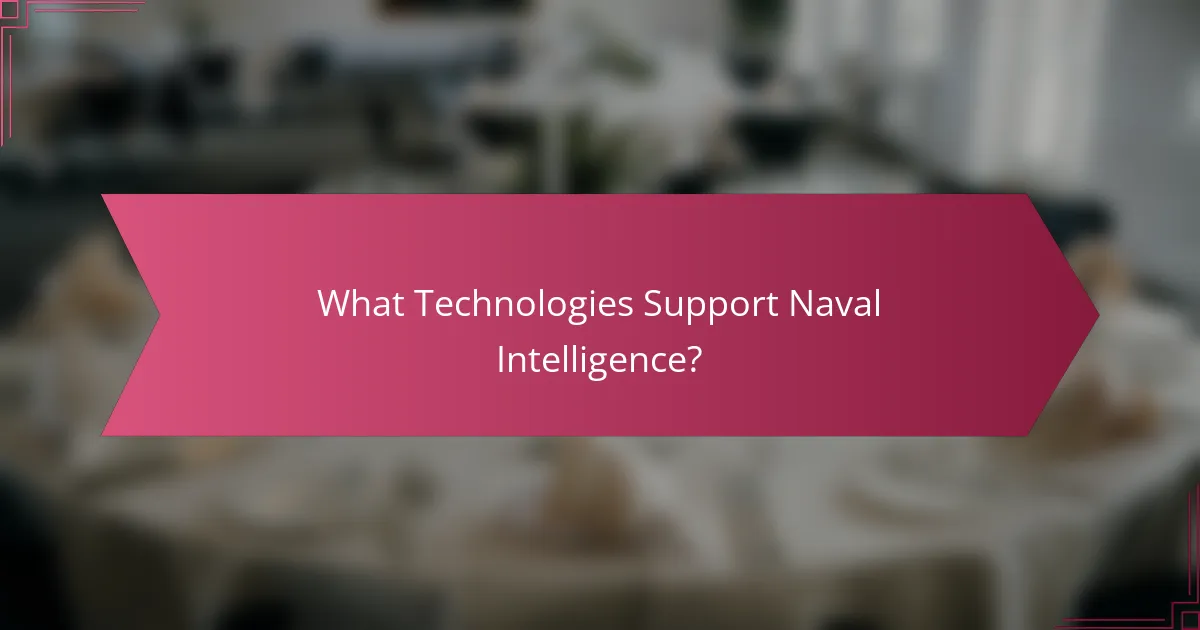
What Technologies Support Naval Intelligence?
Naval intelligence relies on a range of advanced technologies to enhance strategic decision-making, improve information gathering, and ensure effective operations. Key technologies include artificial intelligence, advanced surveillance systems, and robust cybersecurity measures.
Artificial intelligence applications
Artificial intelligence (AI) plays a crucial role in processing vast amounts of data quickly and accurately. AI algorithms can analyze patterns in intelligence reports, satellite imagery, and sensor data, enabling faster decision-making and threat identification.
For example, machine learning models can predict potential adversary movements based on historical data, allowing naval forces to adjust their strategies proactively. Additionally, AI-powered systems can automate routine tasks, freeing personnel to focus on more complex analytical challenges.
Advanced surveillance systems
Advanced surveillance systems are essential for gathering real-time intelligence in naval operations. These systems include satellite reconnaissance, unmanned aerial vehicles (UAVs), and advanced radar technologies that monitor vast maritime areas.
For instance, modern naval fleets utilize synthetic aperture radar (SAR) to detect and track surface vessels even in adverse weather conditions. Integrating these systems with AI enhances their effectiveness, allowing for more precise targeting and threat assessment.
Cybersecurity measures
Cybersecurity is vital for protecting naval intelligence systems from cyber threats. As naval operations increasingly rely on digital technologies, robust cybersecurity measures are necessary to safeguard sensitive information and maintain operational integrity.
Naval forces should implement multi-layered security protocols, including encryption, intrusion detection systems, and regular security audits. Training personnel on cybersecurity best practices is equally important to mitigate risks associated with human error and social engineering attacks.
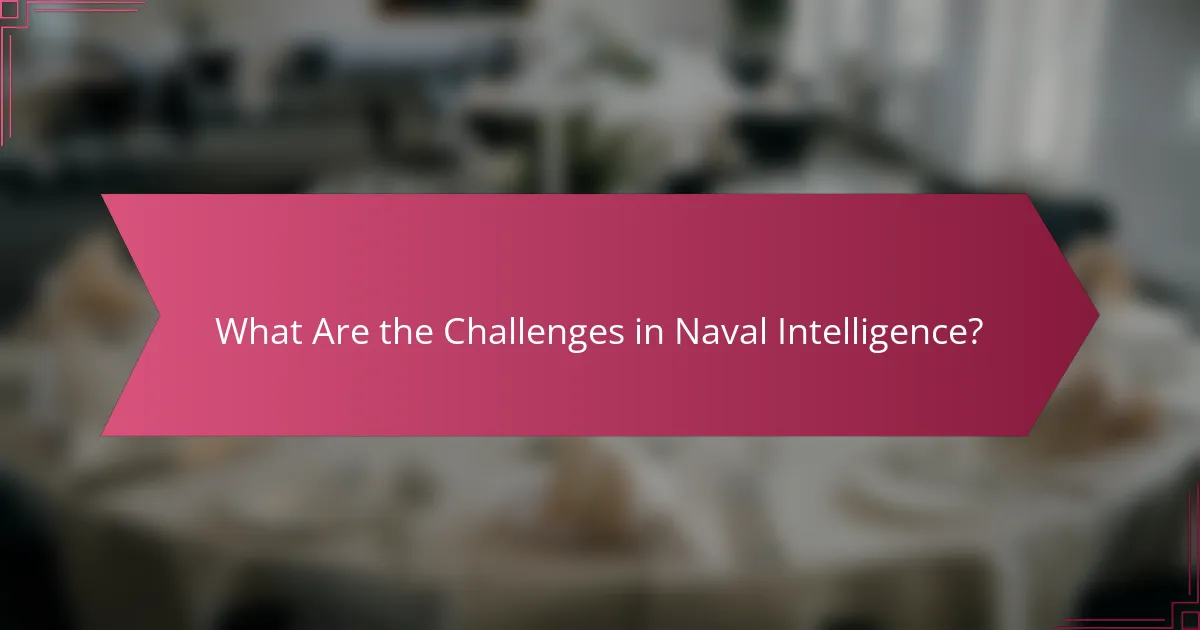
What Are the Challenges in Naval Intelligence?
Naval intelligence faces several challenges that can hinder effective operations, including data overload, interoperability issues between systems, and security vulnerabilities. Addressing these challenges is crucial for maintaining situational awareness and making informed decisions in maritime environments.
Data overload issues
Data overload occurs when the volume of information collected exceeds the capacity to process and analyze it effectively. In naval operations, this can lead to critical information being overlooked or misinterpreted, which may compromise mission success.
To manage data overload, naval forces should prioritize information filtering and utilize advanced analytics tools. Implementing automated systems that highlight key data points can help streamline decision-making processes and reduce cognitive strain on personnel.
Interoperability between systems
Interoperability refers to the ability of different systems and platforms to work together seamlessly. In naval operations, various technologies and software from multiple vendors may not communicate effectively, leading to gaps in intelligence sharing and coordination.
To enhance interoperability, naval forces should adopt standardized protocols and invest in compatible technologies. Regular joint exercises can also help identify and resolve interoperability issues, ensuring that all systems function cohesively during operations.
Security vulnerabilities
Security vulnerabilities in naval intelligence systems can expose sensitive data to adversaries, risking operational integrity. Cyber threats and physical breaches are common concerns that require constant vigilance and proactive measures.
To mitigate security risks, naval forces should implement robust cybersecurity protocols, including regular system updates and employee training on security best practices. Conducting vulnerability assessments can help identify weaknesses and strengthen defenses against potential attacks.
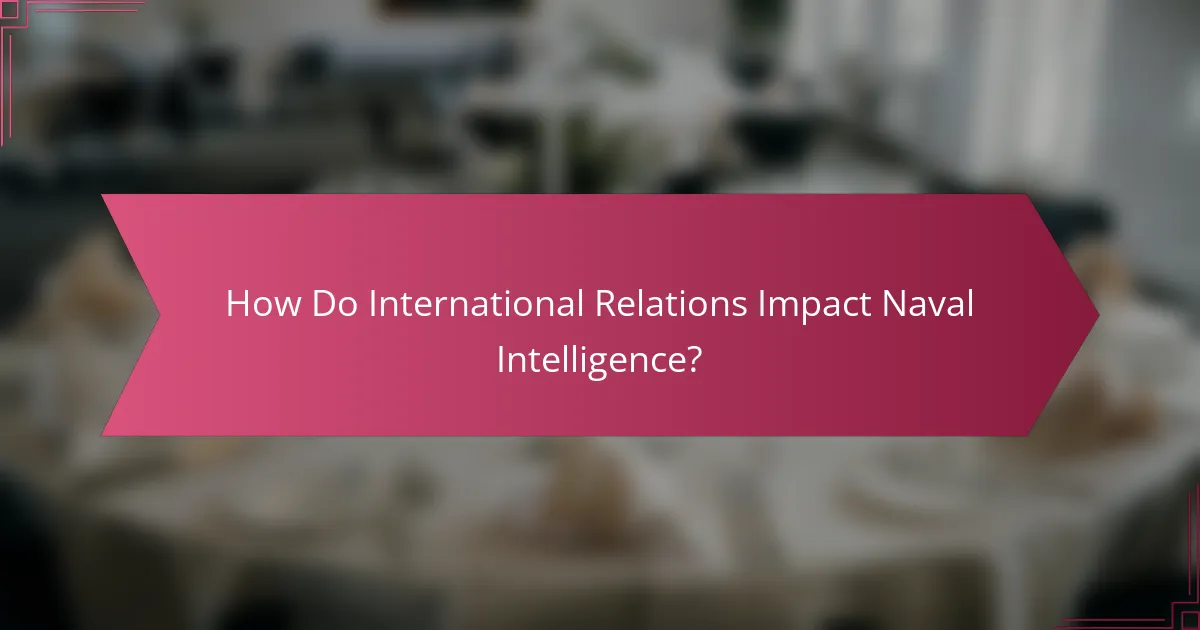
How Do International Relations Impact Naval Intelligence?
International relations significantly influence naval intelligence by shaping the strategic priorities and information requirements of naval operations. The dynamics of alliances, partnerships, and geopolitical tensions dictate how nations gather, analyze, and utilize intelligence to inform their naval strategies.
Alliances and partnerships
Alliances and partnerships enhance naval intelligence capabilities through shared resources and information. For example, NATO members often collaborate on intelligence-sharing initiatives, which improve situational awareness and operational readiness among allied forces.
Countries involved in alliances can benefit from joint exercises and training, which help standardize intelligence protocols and foster trust. However, reliance on partners can also lead to vulnerabilities if one ally fails to provide accurate or timely information.
Geopolitical tensions
Geopolitical tensions create an urgent need for robust naval intelligence to monitor adversaries and assess threats. Nations in conflict or rivalry often increase their intelligence-gathering efforts, utilizing satellite surveillance, reconnaissance missions, and cyber capabilities to gain an edge.
For instance, in regions with high tensions, such as the South China Sea, naval forces may deploy more frequently to collect intelligence on rival activities. This can lead to an arms race in intelligence capabilities, where nations invest heavily in advanced technologies to outpace their competitors.
